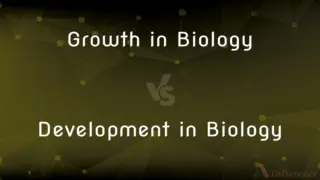Chinese Writing vs. Japanese Writing — What's the Difference?
By Tayyaba Rehman — Published on January 29, 2024
Chinese Writing consists of logographic characters representing words or morphemes. Japanese Writing uses a mix of kanji (Chinese characters) and two syllabaries: hiragana and katakana.

Difference Between Chinese Writing and Japanese Writing
Table of Contents
ADVERTISEMENT
Key Differences
Chinese Writing is a logographic system, where each character represents a word or a meaningful part of a word (morpheme). In contrast, Japanese Writing incorporates Chinese characters (kanji) but also uses two syllabaries, hiragana and katakana, each containing 46 characters representing syllables.
In Chinese Writing, the complexity of characters varies, with no phonetic indication of their pronunciation. Japanese Writing, while using complex kanji like Chinese, complements them with hiragana and katakana, which are phonetic and simpler in structure, indicating pronunciation.
Chinese Writing is consistent across all Chinese-speaking regions, despite variations in spoken dialects. Japanese Writing, with its three-script system, reflects the unique syntax and vocabulary of the Japanese language, differing significantly from Chinese grammar and structure.
The use of Chinese characters in Japanese Writing, known as kanji, is integral but does not cover all aspects of the language. In Japanese, hiragana is often used for grammatical elements and native words, while katakana is used for foreign words and names, a practice not found in Chinese Writing.
Learning Chinese Writing involves memorizing thousands of characters, each with its own meaning and pronunciation. Japanese Writing requires learning kanji, as well as the two kana syllabaries, which adds an additional layer of complexity but aids in reading comprehension through phonetic guidance.
ADVERTISEMENT
Comparison Chart
Script Type
Logographic (characters represent words/morphemes)
Mixed (kanji and two syllabaries: hiragana, katakana)
Phonetic Indication
None (characters have no inherent pronunciation guide)
Partial (through hiragana and katakana)
Regional Consistency
Uniform across regions
Unique to Japan
Usage in Language
Sole script used
Combines kanji, hiragana, and katakana
Learning Complexity
High (thousands of characters to memorize)
Higher (kanji plus two syllabaries)
Compare with Definitions
Chinese Writing
Uniform across various Chinese dialects.
Chinese writing remains consistent despite the wide variety of spoken dialects.
Japanese Writing
Combines logographic kanji with syllabic hiragana and katakana.
Japanese writing uses kanji for roots and hiragana for inflections.
Chinese Writing
Does not include phonetic components to indicate pronunciation.
Learning Chinese writing requires memorizing each character's pronunciation.
Japanese Writing
Katakana is employed for foreign words and names.
Japanese writing uses katakana for words borrowed from other languages.
Chinese Writing
A logographic system where characters represent words or morphemes.
Chinese writing is essential for reading historical texts.
Japanese Writing
Hiragana is used for grammatical elements and native words.
In Japanese writing, hiragana follows kanji to express grammatical nuances.
Chinese Writing
Encompasses traditional and simplified character sets.
Chinese writing in Mainland China predominantly uses simplified characters.
Japanese Writing
Reflects Japanese language's syntax and grammar.
Japanese writing uniquely accommodates the structure of the Japanese language.
Chinese Writing
Characters often have multiple meanings and pronunciations.
In Chinese writing, one character can mean different things in different contexts.
Japanese Writing
Kanji in Japanese often has multiple readings.
A single kanji in Japanese writing can be read in different ways, depending on the context.
Common Curiosities
What is Chinese Writing?
It's a logographic system using characters that represent words or morphemes.
How many characters are there in Chinese Writing?
Thousands, with each character having its own meaning and pronunciation.
What is Japanese Writing?
A combination of kanji (logographic) and two syllabaries: hiragana and katakana.
Can Chinese speakers read Japanese Writing?
They might recognize kanji characters but not understand hiragana or katakana parts.
What are hiragana and katakana in Japanese Writing?
They are syllabaries with 46 characters each, used for different purposes in the language.
Is Chinese Writing the same in all Chinese-speaking countries?
Yes, though there are traditional and simplified versions.
What is the main difference in learning Chinese vs. Japanese Writing?
Learning Chinese involves memorizing many characters, while Japanese also requires learning two additional syllabaries.
Are traditional or simplified characters more common in Chinese Writing?
Simplified characters are common in Mainland China, while traditional characters are used in Taiwan and Hong Kong.
Do Chinese and Japanese Writing share characters?
Yes, Japanese kanji are borrowed from Chinese characters but used differently.
Is pronunciation indicated in Chinese Writing?
No, the pronunciation of characters is not phonetically indicated.
How does Japanese Writing indicate pronunciation?
Through the phonetic scripts hiragana and katakana.
Can knowledge of Chinese Writing help in learning Japanese?
Yes, especially for kanji, but one must also learn hiragana and katakana for Japanese.
Do meanings of kanji differ in Chinese and Japanese?
Yes, the same kanji can have different meanings or nuances in each language.
Are all Japanese words written in kanji?
No, many words, especially grammatical parts and loanwords, are written in hiragana or katakana.
Is it easier to learn Chinese or Japanese Writing?
This depends on the learner, but Japanese may be more complex due to its three-script system.
Share Your Discovery

Previous Comparison
Growth in Biology vs. Development in Biology
Next Comparison
AK47 vs. AK74Author Spotlight
Written by
Tayyaba RehmanTayyaba Rehman is a distinguished writer, currently serving as a primary contributor to askdifference.com. As a researcher in semantics and etymology, Tayyaba's passion for the complexity of languages and their distinctions has found a perfect home on the platform. Tayyaba delves into the intricacies of language, distinguishing between commonly confused words and phrases, thereby providing clarity for readers worldwide.














































